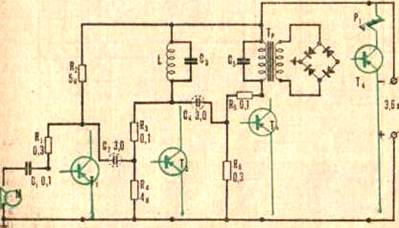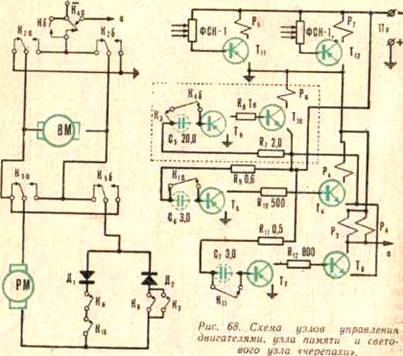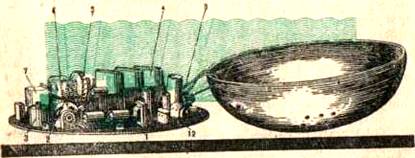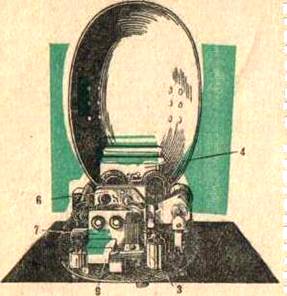
ПроÑÑ‚Ð°Ñ ÐºÐ¸Ð±ÐµÑ€Ð½ÐµÑ‚Ð¸ÐºÐ°
Ðвтор:Е. Копытов, Ð’. Салов, Т. Шорикова
Ðазвание:ПроÑÑ‚Ð°Ñ ÐºÐ¸Ð±ÐµÑ€Ð½ÐµÑ‚Ð¸ÐºÐ°
ИздательÑтво:ÐœÐ¾Ð»Ð¾Ð´Ð°Ñ Ð³Ð²Ð°Ñ€Ð´Ð¸Ñ
Год:1965
———————-
Simple cybernetics
Author: E. Kopytov, V. Salov, T. Shorikova
Title: A simple cybernetics
Publisher: Young Guard
Year: 1965

Thanks to Waldemar Dekański from Poland for locating the source for this Cybernetic Tortoise.
Original Russian text originally used found here.
Pioneer in the practical conduct simulating living creatures is rightly considered to be English neurophysiology Walter Gray. His model "Turtle" can develop a "conditional reflex". It is so designed that, natalkivayas the obstacle, turns back. At the moment of collision with the barrier it is dealt whistle. So is repeated several times, after which the "bug" "learn to" turn back on the whistles, not yet touching obstacles. Whistle indicates "Turtle" the obstacle, sends it to the subject, signals about it. And in this case as the object of action is not himself a whistle and another object – obstacle from the meeting which evaded the bug and the existence of which said a whistle and so. Besides it is worth mentioning the work of Berkeley with his "protein" "Turtles" Ashby. And below the domestic model.
This cyber toy feeds from three batteries for a pocket lamp, this kit is enough for three hours of continuous work. "Turtle" perform the following operations: at power operates the leading engine, and it goes straight ahead; if his motion "turtle" impact on the barrier, it departs ago, and at the same time included a second engine, which makes her turn away from obstacles. When the light hit in the right eye "Turtle" on the right turns, and if zasvete left eye – the left, that is, it always strives to light. If the toy "hears" loud sound, it "frightening" and stops for a few seconds and then goes forward.
"Turtle" able to make a conditional reflex. To this end, in its collision with the barrier must file a whistle, then the model as a mechanism to remember that meets obstacle on the road after the warning whistle, and the next whistle "turtle" has not stopped, but down from an imaginary obstacles.
"Turtle" gathered at the transistors and miniature relay DC-type "RES-10" and "RES-12" and consists of multiple nodes: node sound management of the leading hub motor, motor control lamps, as well as lighting and "memory".
The most difficult knot is sound, which consists of two parts: the actual sound of electronic relays and relay time defining the stop "turtle". Audible relay (Fig. 67) collected on four types of transistors. P14 and works as follows: signals from the microphone comes on the first cascade amplifier voltage

Fig. 67. Scheme sound node "turtle".
sound frequencies. He assembled the regular pattern with earthing emitter.
Enhanced signals received on the next cascade, made on transistors T2. In this chain collector cascade included resonant circuit, made up of inductance and condenser C3. This contour is set to 800 Hz frequency, thus strengthening the cascade will be greatest at frequencies 600 – 1000 Hz. This is necessary in order to "turtle" is not responsive to their own noises, the frequency of which lies within the 50 – 200 Hz.
Last cascade enhance voltage transistors assembled at T3. As a collector of the transistor included output transformer primary winding which is also set to the frequency of 800 Hz through the condenser C5. Various strain, was withdrawn from the secondary winding transformer, rectifier straighten mostikovym gathered at the semiconductor diodes.
Straightening the stress in negative polarity

Fig. 68.
come to the base transistor T4, in the collector circuit which included an executive relay. With the growing negative building at the base of the transistor collector current of his sharply increasing, and the relay is triggered. Contacts K1 lead into effect transistor relay time, collected at the transistors T5 and T6 (Fig. 68). Time relays is a dvuhkaskadny DC amplifier transistors to direct and reverse reducibility with great gain.
The base of the first cascade is connected with less power source through R – S-chain. When the capacitor C6 discharged, based transistor T5 no bias voltage and current collector small. Short-circuiting the capacitor nakorotko S6 contacts K1a by an increase in the relay P1 causes collector current first cascade. This increase, in turn, causes actuation relay included in the second collector transistor. Contacts relay R4 will remain closed until the condenser is not épuisées through resistance R9 and base-station emitter first cascade. Time excerpts depends on the size of the condenser S6, R9 resistance coefficient and strengthen the application of transistors.
Relays P4 has two pairs of contacts: a pair of normally closed, while another – open. Normally closed contacts K 4 and include the food chain motors, and normally open contacts K4b work in a logical pattern Matches "I", with contacts K3 including "memory" "turtle". Thus, when the whistles "turtle" stops for a few seconds.
The collision with an obstacle contacts K11 work related to the buffers. They zakorachivayut capacitor C7 and thus include relay time performance on transistors T7 and T8. The work of this scheme is similar to the above, and requires no explanation. In collector transistor T8 included two electromechanical relays: R2 and R3. Relays R2 reversiruet leading and turning engines – "turtle" moves back and turns aside. Turn happens to read, with more talk through the course of turning motor does not go as a diode D1 is included in the shut-off area. In operation relay R2 polarity supply voltage is changing the engine and a diode D1 conducts current. Turning engine begins to rotate and tougher moves associated with its axis. Tougher leverage through the system turns the front wheels. At the end of the course cams installed hard contact K9, which disables the engine of food. The steering mechanism has three such sustained contact, two of which (K9 and K10) placed in extreme positions cams and an average (K8), when the "turtle" goes straight. Once R2 Cup relay anchor, polarity supply voltage engine change again, and will talk at a price: D2 diode – a vicious contact K 8 – turning motor PM. until tougher than razomknet contact K8. relays R3 works in a logical pattern Matches "I" to include electronic "memory".
"Memory" "turtle" is a time electronic relay, which is designed for 40-60 seconds. It is triggered only when the collision with a barrier and sound (Postal) occur simultaneously, that is, when contacts and K3 and K.4 b. both trapped and zakorachivayut capacitor C5. Relays R6 contacts K6, blocking the food chain engines. Now when filing whistle "tortoise" will not stop and go back, as well as relay R2 and R3 work through contacts K4a and blocked food motors.
In light of "turtle" responds through fotosoprotiv flax, which are connected to amplifiers DC on transistors T11 and T12. In publicizing fotosoprotivle bright light of the negative potential on the basis of one or another transistor increases, causing alarm relay R5 or P7. Contacts relay P7 included parallel contacts K8, that is hard to contact the steering mechanism, and with the closure of "turtle" starts to move left. In operation R5 is changing polarity of the supply steering motor, diode D, conducts current forward, and "turtle" is moving right. "Turtle" mounted on the chassis elliptical shape h180h3 size of 240 mm. Placement of motors, batteries, food, engines and electronic blocks illustrated 69, 70, 71.
As a drive DC motors used type DIP-1, which consume little power and expanded force, sufficient for the traffic of toys and turning it. Leading motor rotation of the wheel passes through the worm gearbox with 1:30 slowdown, worm gear has a direct adhesion wheel. It should be noted that mechanical work must be implemented very carefully:
.jpg)

Fig. 69. "Turtle" withdrawn from "shell" (seen from left).
Transfer of engines should easily rotate and does not have a play, it is desirable to strengthen the wheel of miniature bearings, etc.
Transistors T6, T8, T10-reverse conductivity, or P101 type P8, the rest-type P13 or P14. Tranzistory matched with a small initial shock collector and increased at least 20. Resistance and capacitors – small. Relays P7 and R3 – miniature, type RES-9, relays R2, R5 and R6 – the type RES-9, a relay R1-type RES-10.
All relays are subject to modifications: attenuated spring, approaching contacts in order to reduce the current operation and lower supply voltage. Following changes in the current operation is reduced 2.5 times. The operation also need to produce with sufficient thoroughness and accuracy. To eliminate interference from the sound of engines

Fig. 70. "Turtle" withdrawn from "shell" (seen from right).
node feeds from three successive included battery type "D-0, 06". These batteries are placed in makeshift cassette with the findings for recharging.

Fig. 71. "Turtle" withdrawn from "shell" (rear view). Electrolytic capacitors must be matched with a small current leakage. Microphone – primers such as "DEMSH". The transformer has a core section 1 cm 2. Figures its winding: primary – 500 turns of PE-0, 1; secondary – 150 turns of PE-0, 18.
Forging "turtle" beginning with the sound settings hub. Connect food and to give input signal from the sound generator with a frequency of 900 Hz and amplitude of 5 mv. Selection of tanks and S3 capacitors C5 seeking operation relay at this frequency. If the release occurs when the signal more than 15 mv, transistors should be applied with great gain.

Fig. 72. A general view of "turtle". Then proceed to build a relay time for transistors T5 and T6. To do so closes S6 nakorotko capacitor, a collector in the chain consistently with relay
include milliampermetr. With the closure of S6 current collector rises to 20-25 May and then gradually reduced to 1-3 May. If the value of current with the full discharge condenser will be more May 5, it should change the transistor T5 to another, less current primary collector, or choose an electrolytic capacitor with a small diversion. Time stops "turtle" regulated resistance R9 and is 4-5 seconds. The remaining relay time regulated the same way. Fotorele do not need to adjust, need only use transistors with a relatively high gain.